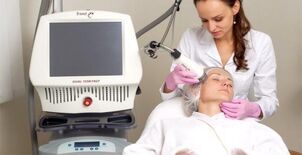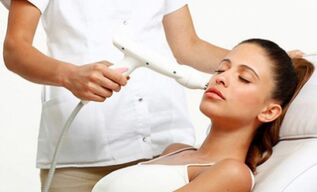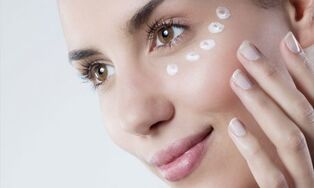Aging is a natural biological process that affects all tissues of the human body, including the tissues that make up a person's appearance. At the same time, facial tissues are more prone to aging than other tissues because they are often affected by environmental factors, chewing, mimicry, and voice functions. Since the face is a person's "visit card", the issue of maintaining and restoring the youthfulness of the facial skin is particularly important and relevant. Among the many methods and techniques used to solve this problem today, laser facial repair deserves special attention.
The essence of this method is the differential effect of the laser beam on the skin. The laser beam is split into many of the finest beams, which affect and evaporate the microscopic areas of the skin (located at strictly specified depths). The intact cells located between these areas stimulate the active production of collagen and elastin-collagen and elastin are the two main "building materials", and as we age, they form less and less in the body. After this step, skin tone will be improved, small and medium wrinkles will be corrected, bags under the eyes will be removed, and the oval shape of the face will be tightened. At the same time, the recovery period is minimized. Fractional laser rejuvenation can not only be used as a standalone method, but can also improve the results of cosmetic surgery or laser skin resurfacing.

Lasers for laser revival
In 2004, Palomar Medical Technologies of the United States obtained the patent for the principle of fractional laser exposure for the first time. Fractional laser systems are currently represented by various laser technology companies. The most widely used laser systems are Palomar and Fraxel, the Affirm laser of Cynosure, and the GentleYAG laser of Candela. Since all these attitudes have a common principle of action, the outcome of the operation largely depends on the professional level of the expert performing the operation.
Contraindications of laser rejuvenation procedures
The absolute contraindications for this process are:
- Pregnancy, lactation.
- The focus of inflammation in the affected area.
- Psoriasis and skin diseases.
- Herpes infection foci in the affected area.
- A chemical stripping of the expected treatment area was performed less than two weeks before the operation.
- Tumor diseases.
- Systemic diseases of blood, immune system and connective tissue.
- Diabetes in the decompensation stage.
- Severe forms of hypertension and coronary heart disease.
- Varicose veins in the operation area.
- Keloid scars are easily formed.
- Family history of vitiligo.
Relative contraindications include frequent exposure to the sun in the last three weeks before surgery, that is, fresh sunburn, as well as superficial and midline skin in the treatment area less than three weeks before surgery.
Some benefits of laser revival
Because of the point effect, the damage to the skin is small, so all the marks after the operation disappear within 3-4 days.
This method allows you to treat a large area of skin in one process, while maintaining and activating the skin's regenerative resources, so that you can quickly recover and have a long-term positive effect.
The procedure does not require anesthesia and can be performed on the neck, abdominal cavity and eye area.
There are few side effects. Possible complications include temporary red-purple spots in the treated area, mild and fast passing itching, activation of herpes infection, changes in skin texture, including burns, peeling, and crusting. Scars, hyperpigmentation and hypopigmentation of the skin in the surgical area are extremely rare, but can be permanent.
What is the complete course of laser revival program
A short laser exposure lasts 20-40 minutes, depending on the nature of the problem and the area to be treated. The repeated process takes place within 3-4 weeks. Usually, a total of 3-4 sessions are required. The maximum positive effect will be produced within three months after the last operation. It is recommended to perform a maintenance session every 10-14 months.

What to do after laser facial rejuvenation surgery
A slight burning sensation may be felt within 1-2 hours after the operation, while the redness and slight swelling may last for 1-3 days. During this period, external preparations (creams, ointments, sprays) containing dexpanthenol should be used, such as Bepanten, Panthenol, D-Panthenol. After the listed symptoms disappear, before the next step, hyaluronic acid cream should be applied.
You can take a bath on the day of the operation, but it is best to wait for the sauna and swimming pool. Foundation can be used one day after surgery.
You must use a sunscreen with a protection factor of at least 30, because the skin's metabolism is activated at this time and it is particularly sensitive to sunlight.
After the program is completed, it is necessary to follow the advice of the expert who performed the program. The choice of cosmetics, the frequency and duration of use are determined separately and depend on the type of skin and its characteristics.
Fractional laser rejuvenation is a cosmetic procedure in which the skin is exposed to a laser array made of microbeams. The purpose of this effect is to activate the regeneration process and collagen production. This is a relatively new but already very popular hardware technology. In another way, it is called Fraxel, partial laser resurfacing or photopyrolysis.
Working principle and variety of segmented laser revival
How does the fractional laser work? The microbeams emitted by the device will cause a thermal shock. Correspondingly, the "lazy" skin cells begin to function more actively. In order to repair damaged areas, they can be separated faster. The old cells that had already failed die, giving way to younger cells. The deep heating of the skin is accompanied by partial denaturation of proteins and the formation of new components of the extracellular matrix, including elastin and collagen.
According to the depth of impact, ablative and non-ablation laser rejuvenation can be distinguished. The first is superficial, similar to grinding. Laser treatment of the upper layer of the skin will be accompanied by water evaporation and damage the epidermis. After healing, the skin becomes softer, and its looseness and color are balanced. In the non-ablative photopyrolysis process, the laser acts on the deep layers of the skin. In this case, no open wound will form.
Each revival has its advantages and time. Therefore, after the first step, the effect of ablative laser resurfacing is obvious. Using this method, deep wrinkles and age spots, acne, stretch marks, and scars can be eliminated. With non-ablative surgery, there is no risk of infection, and the vitality is significantly restored within a few years. It is recommended to use this type of photopyrolysis for people under the age of 40. The earliest signs of aging are: fine lines and wrinkles reduction.
Indications and contraindications of surgery
If possible, a photopyrolysis process can be used:
- sagging, loose skin.
- Fine lines and deep lines, crow's feet.
- Pigmentation from any source.
- Increased sebum secretion.
- Large pores, easy to get acne.
- Scars, stretch marks, post-acne.
- The blood vessels "stars" (rosacea).
- Dull skin tone.
The contraindications of laser resurrection are:
- Allergies, psoriasis.
- Autoimmune diseases.
- Pregnant, breastfeeding.
- Blood diseases.
- Skin infection, inflammation of the area expected to be treated.
- Any chronic disease in the decompensation stage.
- Oncology.
- Increased body temperature.
- Diabetes.
- Keloid scars are easily formed.
- Epilepsy.
Characteristics of laser revival
The preparations for the spectropyrolysis program consisted of denying access to the solarium and beach for two weeks. At all these times, you cannot clean your skin, do chemical peels, take sulfonamides, fluoroquinolone and tetracycline. Three days before the operation, they stopped going to the swimming pool, bathhouse, sauna, and treated the area suspected of contact with alcohol-based cosmetics. In order to prevent complications, beauticians can prescribe antiviral and antibacterial drugs during this period. On the eve of the operation, it should be carried out in a smoke-free and smoke-free environment and avoid going to the gym.
Before laser treatment, clean cosmetics and impurities on the skin. Usually, the effect of the laser is felt as an unpleasant tingling sensation, but sometimes pain relief may be needed. In this case, the beautician applies anesthetic to the prepared skin area. After the ointment worked, he continued to treat the skin with laser. The duration of the procedure depends on the extent of the treatment area, ranging from a few minutes to an hour. Finally, use a nourishing cream to soothe the skin.
On the first day after the operation, you should not use alcohol-based products. Instead, use compressed linen to compress the body parts for photopyrolysis. It is recommended that you do not participate in sports for a week, do not go to the swimming pool, sauna or bath, and limit the time spent on the street. The skin is moisturized with a special cream 3 times a day. Waited for half a month. For peeling, it is not advisable to use cosmetics together with retinol and salicylic acid. Within two months, a cream with a sun protection factor of 35 or higher must be used.
How many processes do you need to get results? What can you expect?
The recovery period after laser partial recovery lasts 3 to 7 days. The speed of recovery depends largely on lifestyle. Drinking, smoking, excessive exercise, unbalanced diet, insomnia and anxiety all slow down the regeneration process.
During the first three days after laser irradiation, redness and slight swelling of the skin may occur. Anesthetics and skin cooling can help reduce discomfort. If you feel tightness in your skin within a week, this is normal and there will be flaky areas. The side effect of this procedure may be a bronze tan, which disappears on its own after half a month.
The lasting result after partial photopyrolysis occurs after 2-5 steps. More specifically, the number of treatment sessions can only be determined by the beautician based on initial data. The procedure interval is 3-4 weeks. Partial laser rejuvenation can inhibit the aging process: wrinkles disappear or become less noticeable, wrinkles increase, pore severity decreases, and skin tone improves. This method is an effective tool against scars, hyperpigmentation, post-acne and stretch marks.
Laser fraction regeneration is one of the three most popular hardware modification programs. Its advantages include high efficiency, short healing period, and strong physiological functions. After the first operation, the results were visible and lasted up to three years. This method has a wide range of indications. You can choose the depth of laser exposure.
Women of any age want to see beautiful skin in the mirror, but not everyone is ready for surgery by plastic surgeons.
In this case, some new students can be saved by using laser, which is the number one anti-aging program in modern cosmetology.
Types and methods of exposure
Ablation photopyrolysis method
There are two photopyrolysis methods, each of which is suitable for different situations. The right choice that supports the best option will help the beautician make the first appointment.
This method is suitable for rejuvenating skin that has just begun to naturally age.
The laser-assisted micro-damage network only affects the upper layer of the epidermis, forcing it to regenerate in a short time.
After the wound has healed, the results will be displayed after the first step.
Non-ablation photopyrolysis method
This method is a slightly more serious intervention. The laser beam penetrates the deep layers of the epidermis, ignoring external cells.
The injury also promotes the production of elastin and collagen, just like ablative photopyrolysis.
The recovery process takes longer and the effect is more obvious. Suitable for removing serious facial problems.
Reading
Anyone who wants to rejuvenate without braces can use this method.
Some laser treatments can eliminate many facial blemishes, including:
- There are obvious wrinkles on the forehead;
- Nasolabial fold;
- The crow's feet are wrapped around the eyes;
- The epidermis "flows down";
- Skin pigmentation, scars, scars, spider veins;
- Large pores and acne problems.
Laser treatment has been proven to be very effective in eliminating all these problems.
The only caveat is that, depending on the severity of the defect, several steps may be required.
Contraindications
Like any other external effects on the human body, low-dose laser rejuvenation has its own contraindications. In this case, this method is prohibited.
This includes:
- Severe facial inflammation;
- Infectious and fungal skin lesions; Epidermal diseases-psoriasis, eczema;
- Excessive dry skin;
- Malignant tumors in the body;
- History of epilepsy;
- Heart disease;
- Facial varicose veins;
- Herpes is in the acute stage;
- pregnancy, breastfeeding;
- Immunodeficiency status;
- Bronchial asthma, severe allergic reaction;
- Nervous system diseases.
All contraindications are conditional, that is, the beautician must weigh all the risks of the patient.
Sometimes, you should first receive treatment for skin problems or wait for the relief of chronic diseases, and then you can still regain youth.
Preparation
Since the intervention is not a surgical operation, no serious preparation is required. Initially, you should consult a beautician, who will evaluate the skin condition and advise on the necessary methods of photorejuvenation.
The patient must inform the doctor of all conditions and diseases in the history, as well as the deterioration of chronic diseases in the past six months.
If so, the expert will recommend that you see a specialist to evaluate the safety of the operation.
You should also perform blood and urine tests to identify or rule out inflammatory processes in the body. Then set the date of the first visit.
execute
The local laser skin repair of the facial area is performed on an outpatient basis, that is, the patient comes in, receives treatment and then goes home.

The beautician first applies lidocaine-based anesthetic cream or ointment on the epidermis.
Actually, the process is not too painful, so sometimes there is no need to go through this stage for treatment.
Please note that the use of local anesthetics will inhibit the natural regeneration of the skin in the future.
Then, the patient lies on the sofa, and the expert adjusts the penetration depth of the laser beam on a special device. The device is aimed at certain areas of the epidermis that the laser penetrates.
The operation lasts for half an hour or more, depending on the area to be processed by the device. During the operation, the patient may feel a slight tingling sensation and an unpleasant smell.
After the meeting, there was a red spot on the face immediately, and the skin was red and slightly swollen, so it is best to take care of home in advance.
Possible complications
Partial rejuvenation does not rule out complications. In some cases, they are normal and will disappear after a few days.
The appearance of others is due to insufficient experience of the beautician or lack of proper facial care during the recovery period.
What the specification is not:
- Severe pain or swelling at the laser beam irradiation site;
- The lesion cannot heal within two weeks;
- Pigmentation and scars appear.
For any type of epidermis, pale red, peeling and itching are all predictable conditions.
Such consequences will disappear on their own within 1-2 weeks without leaving any visual defects.
Rehabilitation
The outcome of this process is largely influenced by the patient's own behavior. He must carefully monitor the skin to protect it from aggressive environments and refrain from applying decorative cosmetics during the healing period.

General guidelines:
- The first three days of the wound should be lubricated with an ointment based on difentanyl,it will promote the rapid healing of micro injuries. Afterwards, it is recommended that a beautician recommend using a light moisturizing cream containing hyaluronic acid.
- No washing is allowed.Within 2 weeks, the epidermis should not be exposed to high temperatures, so it is best not to use baths and saunas, and do not take hot baths.
- Do not go out without sunscreen, it is best to choose from 50 protection levels. If you don't do this, hyperpigmentation will occur. Even if you are outside in winter, you should apply makeup until fully healed.
A few weeks later, it is recommended to go to some experts who do laser rejuvenation again. He must assess the condition of the facial skin and rule out complications.
Forecast
If the blemish is not obvious, you can see the result immediately after healing. Deep wrinkles or scars must be removed through several treatments.
Visually, in 99% of the cases, the skin is smoother, has a natural color, and the face is tight and blooms visibly.
1% are dedicated to unforeseen circumstances, improper care, and doctor’s qualifications.
Advantages of the method
For many patients, this method has obvious advantages and is worth mentioning. By choosing photopyrolysis, one will receive the following message:
- Low cost, high efficiency;
- Painless;
- The effect even comes from a process;
- Non-invasive;
- lacks strong side effects.
In addition, the effect of laser can immediately solve several problems of the aesthetic composition of the epidermis, which is good news.
Disadvantages
If you choose the wrong rejuvenation clinic or do not strictly follow the advice of the beautician, you will win huge age spots on half of your face, which are difficult to remove.
In addition, laser treatment takes a long time. During this period, patients will feel an unpleasant smell of damaged skin, which not everyone can bear.
Another disadvantage is that the results of the surgery are incomplete due to deep depressions, scars and wrinkles.
Comment review
Cosmetology is becoming more and more popular in cosmetology. Every year, more and more women choose lasers instead of scalpels.















































































